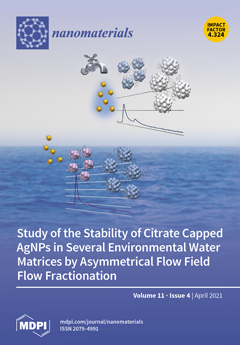In the last years, the plant-mediated synthesis of nanoparticles has been extensively researched as an affordable and eco-friendly method. The current study confirms for the first time the capability of the
Otostegia persica (Burm.) Boiss. leaf extract for the synthesis of silver nanoparticles
[...] Read more.
In the last years, the plant-mediated synthesis of nanoparticles has been extensively researched as an affordable and eco-friendly method. The current study confirms for the first time the capability of the
Otostegia persica (Burm.) Boiss. leaf extract for the synthesis of silver nanoparticles (AgNPs). The phytofabricated AgNPs were characterized by ultraviolet–visible spectroscopy (UV-Vis), Fourier-transform infrared spectroscopy (FTIR), X-ray diffraction (XRD), transmission electron microscopy (TEM), and zeta potential analysis. Moreover, the total phenolic and flavonoids contents, and the antioxidant, antibacterial, antifungal, and anti-inflammatory properties of the phytofabricated AgNPs and the
O. persica leaf extract were assessed. The results showed that the produced AgNPs were crystalline in nature and spherical in shape with an average size of 36.5 ± 2.0 nm, and indicated a localized surface plasmon resonance (LSPR) peak at around 420 nm. The zeta potential value of −25.2 mV pointed that the AgNPs were stable. The phytofabricated AgNPs had lower total phenolic and flavonoids contents than those for the
O. persica leaf extract. The abovementioned AgNPs showed a higher antioxidant activity as compared with the
O. persica leaf extract. They also exhibited significant antibacterial activity against both Gram-positive (
Staphylococcus aureus,
Bacillus subtilis, and
Streptococcus pyogenes) and Gram-negative (
Escherichia coli,
Pseudomonas aeruginosa, and
Salmonella typhi) bacteria. In addition, appropriate antifungal effects with the minimum inhibitory concentration (MIC) values of 18.75, 37.5, and 75 µg mL
−1 against
Candida krusei,
Candida glabrata, and
Candida albicans, respectively, were noted for this new bionanomaterial. Finally, the phytofabricated AgNPs showed dose-dependent anti-inflammatory activity in the human red blood cell (RBC) membrane stabilization test, being higher than that for the
O. persica leaf extract. The resulting phytofabricated AgNPs could be used as a promising antioxidant, antibacterial, antifungal, and anti-inflammatory agent in the treatments of many medical complications.
Full article






